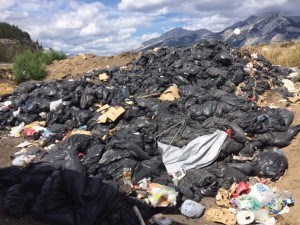
The Jasper Environmental Association (JEA) wants Parks Canada to clean up its act and change the way it disposes of ash from Jasper National Park’s campgrounds.
During the summer of 2015, former Jasper resident Kim Wallace learned that each day during camping season, campground staff would scoop up ash and debris from dozens of fire pits in the park and put it into plastic garbage bags—the bags would then be double bagged and trucked off to the Jasper Transfer Station.
“Considering Parks’ conservation mandate, I found it very disturbing,” said Wallace in an interview. “I had a picture of all these plastic bags from just one day on my Ipad and I kept seeing it...I just couldn’t let it go.
“It’s just so unnecessary to put something that is biodegradable into plastic bags that will end up sitting in a landfill.”
In February 2016, Wallace emailed her frustrations to JNP superintendent Alan Fehr, urging him to reconsider the way Parks Canada disposes ash.
“I highly suggest that you consult with your campgrounds and waste management resources to come up with better ideas than the one used to deal with this issue in the summer of 2015,” Wallace wrote in her email. “This is shameful.”
A few weeks later, Fehr wrote back to Wallace acknowledging her concerns and agreed there was an issue.
“Each year we review our waste management practices to take into consideration issues like this. We strive to improve our processes, take advantage of new products and innovative practices to manage waste in a way that protects our special places for future generations to enjoy,” Fehr wrote to Wallace. “Your concern and suggestions will be part of the discussion this year.”
However, in July 2016, Wallace said she found out Parks was still using the same process so she sent Fehr another email.
On behalf of Fehr, his executive assistant, Megan Vicente replied to Wallace. The email stated that JNP’s visitor experience and campground staff are working towards implementing a new approach for the summer of 2017.
“I felt like I was getting the runaround,” Wallace said. “It was a very rhetorical response.”
Frustrated by the lack of action, Wallace contacted the JEA at the beginning of August. JEA member David Hatto said since being notified about the ash issue, the association plans to sit down with Parks staff to discuss an alternative solution.
“Basically our stance is that something has to be done about it,” Hatto said. “There are solutions readily available.”
Hatto suggested that Parks collect the ash in large bins—without the bags—and then truck the ash off to a suitable area where it can decompose naturally.
“Ash is very good for gardens in reasonable amounts because it has the right chemicals to assist with growth, but it can also be used for other purposes,” Hatto said. “The first thing is it’s biodegradable...ash won’t harm the environment provided it’s not too close to running water—you don’t want it 10 feet from the Athabasca (River) because then you get too much concentration.”
If Parks starts letting the ash decompose naturally, Hatto said the agency will also have to implement some sort of screening process to remove garbage.
“The only issue with that is what else is in the fire pits, but it wouldn’t be difficult to put a screen across a garbage bin when they dump the ash,” Hatto said. “The screen would remove any unwanted items like cans and melted plastic.”
Steve Young, a communications officer with Parks Canada, confirmed that the agency is in the midst of reviewing its practices for ash removal from campgrounds in the park as part of a larger and more comprehensive look at its approach to waste management.
“With respect to future ash collection and disposal, Parks Canada has reviewed industry standards and has been consulting with experts and will begin testing elements of new approaches in the next few weeks,” Young said. “This will allow for operational review and refinement prior to full implementation of a new process for 2017.”
Kayla Byrne
[email protected]
